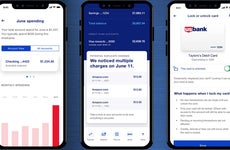Digital banking trends in 2024

The Bankrate promise
At Bankrate we strive to help you make smarter financial decisions. While we adhere to strict , this post may contain references to products from our partners. Here's an explanation for .
Digital banking encompasses various banking tools and trends, but one thing is certain: Digital banking is on the rise. Most Americans have used digital banking services in the past year, and more banks are offering new, innovative digital tools, from AI-powered budgeting to new ways to purchase everyday items.
“New technologies continue to evolve how we pay for things and manage our money, all with the promise of simplicity and convenience,” says Christine Roberts, EVP and President of Citizens Pay.
The rise of digital banking has coincided with a decline in the presence of traditional banks, which have faced a loss of more than 2,500 branches across the country in 2023, according to data from the Federal Deposit Insurance Corp. (FDIC). While traditional banks offer access to branches, digital banks — those offering only online and mobile banking services — often provide attractive yields and low (if any) bank fees.
Here’s everything you need to know about digital banking trends in 2024 and how they compare to traditional banking statistics.
Key takeaways
- Digital banking continues to grow, with most Americans having used digital banking services in the past year. This trend coincides with a decline in traditional banking, with over 2,500 branches having closed across the country in 2023.
- Innovations in digital banking, such as AI-powered budgeting tools and mobile payment platforms, are transforming the banking landscape.
- Some digital banks are also using AI to enhance customer experience and increase productivity.
- Despite the increasing popularity of digital banking, many customers still value the presence of physical branches.
Key statistics on digital banking
- A significant majority of consumers (71 percent) prefer to manage their bank accounts through a mobile app or a computer. (American Bankers Association)
- The generation that’s most likely to prefer digital banking is millennials (74 percent), while Generation Z is the least likely (68 percent). (ABA)
- Consumers are generally satisfied with their banks’ digital offerings, with 97 percent rating their mobile and online banking experience as “excellent,” “very good” or “good.” (ABA)
- Additionally, 79 percent of customers say digital innovations in banking are making banking services more easily accessible. (ABA)
- Despite the fact that few prefer branch banking over digital banking, 38 percent of customers say branches are essential. (J.D. Power)
- Of customers who don’t have an online bank account, 46 percent say it’s because they prefer access to a branch, and 30 percent cite security concerns. (Bankrate)
- Around 4.5 percent of Americans are unbanked, meaning they have no bank accounts. (FDIC)
Traditional banking vs. digital banking
Traditional banks are those that have a physical presence, and many of the largest U.S. banks, including JPMorgan Chase and Bank of America, are considered traditional banks. Online-only banks don’t have branches, and they may offer services both via desktop website and mobile apps.
The fintech firm Galileo found that 65 percent of consumers use traditional banks for their primary bank accounts, while JD Power reports that 27 percent primarily use online banks, as of 2022. However, of the 65 percent using traditional banks primarily, 77 percent said that they keep some of their funds elsewhere.
Here’s a look at the differences between traditional and online banks and the advantages of each.
| Traditional banking | Digital banking | |
|---|---|---|
| * The remaining share of consumers who have their primary account outside of a traditional or a digital bank may primarily bank with a credit union or be unbanked. | ||
| Services | Primarily branch banking, though some may also offer online accounts | Primarily online and mobile banking |
| Common savings account interest rates | 0.01% – 0.02% APY | 4.00% – 5.10% APY |
| Share of consumers’ primary accounts | 65%* | 27% |
| Advantages |
|
|
| Disadvantages |
|
|
Traditional banking trends
Traditional banks — those that have a physical presence — are still the predominant financial institution where people keep their primary bank accounts. However, their reach is declining.
Between 2017 and 2021, 9 percent of all branch locations closed, a loss of around 7,500 branches, according to the nonprofit National Community Reinvestment Coalition (NCRC). A third of those closures were in low- to moderate-income or historically marginalized neighborhoods.
In 2023, the FDIC reported an additional 2,555 bank branch closures, or about a 3 percent loss of total branches. The advantages of online banking (lower fees, ease of access) have recently affected the way that many traditional banks do business. One significant change in traditional banking over the past few years has been the elimination or reduction of overdraft fees. Citibank, PNC Bank and U.S. Bank are three of several of the banks that have eliminated or decreased their overdraft fees.
Most large, traditional banks also now offer comprehensive mobile apps, where consumers can complete basic banking transactions such as transferring funds between accounts, checking account balances and making mobile check deposits. Some of these apps even come with advanced tools like automatic savings features.
Several traditional banks also offer account opening bonuses to incentivize consumers to open an account with them.
One feature common to traditional banks is the offering of in-person services with a bank teller. Data shows that older generations are more likely to prefer speaking to a bank teller as their primary method of account access than younger people. Here’s how it differs by age, according to a 2023 survey by the ABA.
| Age group | Percent who prefer in-person banking services |
|---|---|
| 12-27 | 4% |
| 28-43 | 4% |
| 44-59 | 9% |
| 60-78 | 16% |
Key statistics
- At the time of this writing, there were 79,833 FDIC-insured bank branches across the U.S. (FDIC)
- The bank with the most branches is Chase Bank, which has around 4,900 branches in the U.S. and abroad, as of the time of this writing. (FDIC)
- Between 2019 and 2021, consumers’ use of a bank teller to access accounts declined from 21 percent to 14.9 percent. (FDIC)
- About a third (31 percent) of banked households primarily used physical channels, such as a bank teller or ATM, to access their accounts in 2021. (FDIC)
- While 38 percent of consumers consider bank branches to be essential, 72 percent say they plan to use their bank’s branches at the same rate in 2024. (J.D. Power)
- About two-thirds (66 percent) of consumers like to see bank branches in their neighborhoods. (Accenture)
- About one-third of the branch closures that occurred between 2017 and 2021 were in low- to moderate-income neighborhoods or neighborhoods made up of predominantly racial minority residents. (NCRC)
Digital banking trends
Digital banking encompasses a wide range of mobile and online platforms that provide banking services. While digital banking services don’t have branches, they may be part of large ATM networks or allow for in-store cash deposits/withdrawals.
Digital banking is becoming more popular with consumers. Use of mobile banking as the primary method of account access, for example, increased from 15.1 percent of consumers in 2017 to 48 percent in 2023.
Innovations in digital banking are also changing the way we pay for things. “Digital wallets, mobile payment platforms, and contactless payment options continue to rise in popularity, transforming the payment landscape and bringing consumers more choices,” Roberts of Citizens Pay says.
She notes how biometric technology is growing in digital payments. “Imagine tapping your finger to pay at the grocery store or receiving authorization on a loan with a quick eye scan – companies like Mastercard are even testing paying with a smile,” she says.
Another digital banking trend is the use of AI to aid in everyday banking needs.
Many digital banking services are implementing AI technology in their platforms, such as the neobank Dave. Dave’s CEO and Founder, Jason Wilk, says, “AI will become more pervasive across all functions, from marketing and risk management to member support, as neobanks discover effective ways to enhance the customer experience and increase productivity without adding cost. We’re witnessing impressive outcomes from our proprietary AI-driven underwriting model.”
Digital banking by age
Digital banking is somewhat more popular among younger generations, though it’s the preferred method of banking among all generations. About three quarters (74 percent) of millennials prefer to bank digitally, the highest of any generation, according to the ABA.
Here’s how use of digital banking channels (categorized as online and mobile banking) as consumers’ primary method of banking differs across age groups:
| Age group | Percent who primarily use online banking | Percent who primarily use mobile banking |
|---|---|---|
| Source: ABA 2023 survey | ||
| 12-27 | 11% | 57% |
| 28-43 | 14% | 60% |
| 44-59 | 17% | 52% |
| 60-78 | 39% | 31% |
Digital banking by race/ethnicity
According to the FDIC, households made up of two or more races are most likely to use mobile banking as their primary method of accessing bank accounts, and white households are most likely to use online banking primarily.
Over half (52.3 percent) of multiracial households reported mobile banking as their primary method, while 45.4 percent of Black households and 41.1 percent of white households reported the same. Meanwhile, 25.8 percent of white households primarily bank online, compared with 25.7 percent of Asian households and 12.1 percent of Black households.
| Race/ethnicity | Percent who primarily use online banking | Percent who primarily use mobile banking |
|---|---|---|
| Source: FDIC’s 2021 National Survey of Unbanked and Underbanked Households | ||
| Two or more races | 20.6% | 52.3% |
| Hispanic | 11.6% | 49.6% |
| Asian | 25.7% | 48.6% |
| Black | 12.1% | 45.4% |
| White | 25.8% | 41.1% |
| Native American or Alaska Native | 13.3% | 50.6% |
Key statistics
- As of 2023, mobile banking is the primary choice of account access for 48 percent of U.S. consumers, making it the most prevalent banking method. (ABA)
- Digital wallets, such as PayPal and Apple Pay, continue to grow, with about 60 percent of consumers saying they used a digital wallet at least once in the past month. (Banked)
- Of millennials and Gen Zers, 45 percent say they only bank digitally. (BMO)
- Digital banking isn’t only important for ease of access – 59 percent of consumers say they want digital banking services to include financial literacy tools and resources. (BMO)
Online banking
Online banking makes it easy for customers to open and check up on their bank accounts from any location where they have internet access. In addition to digital-only banks, many traditional banks offer online accounts too, such as the 360 Checking account from Capital One.
Without the cost of establishing and operating physical branches, online banks can redirect those funds elsewhere, such as yields offered on savings products or ATM fee reimbursements. Most of the top savings account rates are offered by online bank accounts.
According to Bankrate’s savings rates survey, 30 percent of consumers say the reason they don’t have an online savings account is they’re concerned about the security of their money. Online banks are just as safe as traditional banks, as long as they’re insured by the FDIC, which covers up to $250,000 per depositor, per account type. Bank websites are encrypted to prevent cybercrimes, and they typically require multi-factor authentication to ensure that no one hacks into your accounts.
Some online banks focus on a particular cause or consumer group. Limelight Bank, for example, invests the deposits from its certificates of deposit (CDs) into solar panel initiatives. Valley Bank, a regional bank with online services, has accounts specifically designed for those working in the cannabis industry, including cultivators and wholesalers of cannabis.
Here are some of Bankrate’s picks for the best online banks:
| Bank name | Best for | Why we like it |
|---|---|---|
| Ally Bank | All savers |
|
| TIAA Bank | Interest-bearing checking account |
|
| Quontic | ATM accessibility |
|
| LendingClub | Rewards checking |
|
| CIBC USA | High-interest CDs |
|
Online banking by generation
Younger consumers are gravitating more toward online-only banks. The highest percentage of those interested in online-only banking is among those ages 18-24 – 42 percent say they’re either very likely or somewhat likely to use an online-only bank for their primary bank account, according to CivicScience data. Those ages 55 and above are the least likely to do so, at 11 percent.
| Age range | % who are likely to use an online-only account as primary account |
|---|---|
| Source: CivicScience | |
| 18-24 | 42% |
| 25-34 | 34% |
| 35-54 | 15% |
| 55+ | 11% |
Mobile banking
Many digital banks offer mobile apps where customers can complete basic banking activities, such as checking their balances and transferring funds between their own accounts or to peers.
Mobile banking as a primary method of accessing bank accounts has increased greatly in recent years. In 2017, it was the primary method of banking for 15.1 percent of Americans, according to the FDIC; this has since increased dramatically, reaching 48 percent (from ABA data), becoming the most prevalent primary method.
The benefits of mobile banking include:
- Convenient access: You can access the bank’s mobile app anywhere there’s an internet connection.
- Mobile wallets: Bank accounts can be connected to a digital wallet, such as Apple Pay, to make contactless payments in stores or online.
- Fraud alerts: Mobile bank apps frequently come with a variety of alerts that users may set up to notify them of any suspicious activity or large transactions.
- Send money between peers: You can connect your bank account to a peer-to-peer (P2P) payment app to send money to friends and family with a few taps. Many banks even have Zelle, a popular P2P app, built into their mobile banking app.
- Pay bills: Some mobile banking apps allow you to set up mobile bill payments. You just need to add the biller’s information to make a payment to them.
- Deposit checks easily: You can deposit checks through a mobile app by taking pictures of the front and back of the check. The images are processed by the bank to make sure the check is valid.
- Predictive budgeting tools: More and more frequently, mobile banking apps are using AI to analyze and predict users’ spending habits. The apps can then turn its analysis into actionable advice and insights on how to budget more effectively.
Here are some of Bankrate’s picks for the best mobile banking apps:
| Financial institution | Best for | Why we like the app |
|---|---|---|
| Chase Bank | Automated savings features |
|
| Bank of America | Virtual assistance |
|
| Huntington Bank | Predictive money tools |
|
| Capital One | Account alerts |
|
| Chime | Cutting-edge technology |
|
Key statistics
- About eight-in-10 (81 percent) of consumers have used a mobile device to manage their bank account at least once in the past month – that percentage is even higher, at about 90 percent, for adults ages 18 to 44. (ABA)
- Over half (59 percent) managed their bank account from a mobile device at least three times in the past month. (ABA)
- Up from 34 percent four years ago, now 60 percent of consumers say they’ve used a mobile app to make a payment or transfer money in the past year. (ABA)
- Mobile banking was the primary method of account access for 48 percent of Americans in 2023, compared with 9 percent who primarily visited branches. (ABA)
- The most valued mobile banking feature to users is the ability to lock a lost or stolen card, with 83 percent considering it critical or important; the second-most valued feature is mobile check deposit (79 percent). (Mitek Systems)
- Even as mobile banking becomes more commonplace, 80 percent of users have concerns about their personal information being compromised due to their reliance on mobile banking. (Mitek Systems)
How to open a digital bank account
Opening a bank account online is not too different from opening an account at a branch. The required documentation is generally the same, and it doesn’t take long to do.
First, make sure to find an account that fits your needs. One way that digital bank accounts differ from traditional accounts is that they may offer much higher yields and lower fees. The market for savings accounts is much more competitive with digital banks.
Because the account is digital, you won’t need to worry about looking for local branches. However, you may want to consider access to ATM networks, so that you can easily take out cash.
When submitting an application for an account, make sure to have the following information prepared:
- Social Security number
- Driver’s license or government-issued ID
- A bill with your name and address on it
- Other bank account and routing numbers to fund the new account
Once your application is approved, you’ll need to fund the new account. A common way to do this is by linking an external account and transferring funds into the new account. You may also be able to fund the account by making a mobile check deposit or by sending money through a P2P app, such as Zelle or PayPal.
Frequently asked questions
-
Digital banking is a trend in the banking sector where consumers primarily engage in banking activities – such as managing accounts, paying bills and making everyday purchases – online or on a mobile app.
-
While many banks and fintechs offer banking services through digital channels, there are some banks that are exclusively digital, meaning they have no branches. Brick-and-mortar banks such as Bank of America and Capital One offer digital banking services, but they are not digital-only.
-
Mobile banking is a service provided by many banks that allows customers to access their bank accounts through a mobile device. Banks frequently offer mobile banking apps that customers can download to their smartphones, and these can be used to check account balances, deposit checks and pay bills.
-
Online banks are generally safe. As long as the bank is insured by the FDIC, up to $250,000 of deposits per depositor, per account type are protected if the bank fails. Online banks’ websites also come with enhanced safety measures against cybercrime, including encryption and two-factor authentication.
-
A neobank, sometimes called a challenger bank, is a type of digital-only bank or fintech company — often a startup — that focuses on technological advancement and unique offerings. Neobanks may not be chartered, but they often partner with traditional, FDIC-insured banks to store deposits and ensure federal coverage.
Related Articles


9 bank accounts with built-in budgeting tools to help track your personal finances

